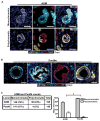Pancreatic Cancer Metastases Harbor Evidence of Polyclonality
- PMID: 26209539
- PMCID: PMC4657730
- DOI: 10.1158/2159-8290.CD-15-0120
Pancreatic Cancer Metastases Harbor Evidence of Polyclonality
Abstract
Studies of the cancer genome have demonstrated that tumors are composed of multiple subclones with varied genetic and phenotypic properties. However, little is known about how metastases arise and evolve from these subclones. To understand the cellular dynamics that drive metastasis, we used multicolor lineage-tracing technology in an autochthonous mouse model of pancreatic cancer. Here, we report that precursor lesions exhibit significant clonal heterogeneity but that this diversity decreases during premalignant progression. Furthermore, we present evidence that a significant fraction of metastases are polyclonally seeded by distinct tumor subclones. Finally, we show that clonality during metastatic growth-leading to either monoclonal or polyclonal expansion-differs based on the site of metastatic invasion. These results provide an unprecedented window into the cellular dynamics of tumor evolution and suggest that heterotypic interactions between tumor subpopulations contribute to metastatic progression in native tumors.
Significance: Studies of tumor heterogeneity indicate that distinct tumor subclones interact during cancer progression. Here, we demonstrate by lineage tracing that metastases often involve seeding by more than one clone and that subsequent cellular outgrowth depends on the metastatic site. These findings provide insight into clonal diversity and evolution in metastatic disease.
©2015 American Association for Cancer Research.
Conflict of interest statement
Conflict of Interest: The authors have no conflicts to disclose.
Figures






References
-
- Hanahan D, Weinberg RA. Hallmarks of cancer: the next generation. Cell. 2011;144:646–74. - PubMed
-
- Talmadge JE, Wolman SR, Fidler IJ. Evidence for the clonal origin of spontaneous metastases. Science. 1982;217:361–3. - PubMed
-
- Friedl P, Locker J, Sahai E, Segall JE. Classifying collective cancer cell invasion. Nat Cell Biol. 2012;14:777–83. - PubMed
Publication types
MeSH terms
Substances
Grants and funding
LinkOut - more resources
Full Text Sources
Medical
Molecular Biology Databases

